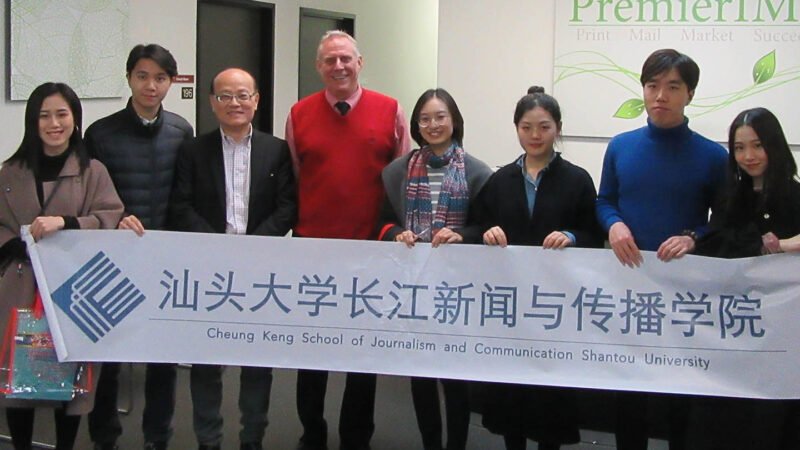UH Digital Media Student Wins GEA Awards
PremierIMS CEO Norm Pegram teaches Printing Materials and Processes at the University of Houston’s College of Technology. One of his students, Kinza Muzahir won three student awards at the Graphic Excellence Awards presented by the Printing Industries of the Gulf Coast (PIGC). The PIGC Graphic Excellence Awards Competition recognizes the best in technology and artistry from the printing, imaging, finishing, and creative communities. We spoke with Kinza about her graphic works and her plans for the future.
What is your major and classification?
I’m a Junior and a Digital Media major at the University of Houston. I’m also pursuing a dual minor in Creative Work (through the UH Honors College), and Organizational Leadership & Supervision.
What class(es) in the Digital Media program do you enjoy the most and why?
Any class that isn’t a traditional Power Point class grabs my attention immediately. Those in which I learn how to operate new equipment are my absolute favorite. They allow me to work on projects that can be added to my portfolio and enhance my skill set. Graphic Production Process Control and Video Production have given me some insight into the paraphernalia front of digital media. I’d say these take the cake. Besides that, my interest peaks in those classes where we go on field trips and/or interact with industry professionals. We’ve done that in Venue Transmedia, Photography, Content Strategy and Digital Media Materials & Processes. As an advocate of interactive learning, I’d say these take the top tier of that cake we just mentioned. Some of them also help with networking and I find that very helpful as a college student.
After you graduate, what type of job will you be looking for? Is there a particular company or position that piques your interest?
I had the pleasure of touring Staging Solutions as it spun stars before my eyes. One of their employees inquired after my thesis project that I had only mentioned in passing, spoke to me about it for nearly 40 minutes, and gave me pointers to think about. That’s always uplifting. The Printing Museum was another one that gave me all sorts of ideas about how I could possibly get involved and help them evolve. I’m a huge museum nerd so to come across one that offers bookbinding, paper making and lithographic printing for artists is a goldmine. I’m so glad they recovered after the fire; it promises the reach to new heights! Imageset, especially because it’s run by a woman, and produces high quality work, is on my list of places I would love to work and learn at. Currently, I’ve very ambitiously applied to The New York Times’ application to be a contributor for their newsletter, The Edit. They’re sifting through 20,000 applications but my uncle says if I know I can do it, I shouldn’t worry about the odds. I’m also planning the launch of my start-up, Kinoo, and am an emerging writer, performance poet, and voice over artist. That means I clearly have a lot to look forward to once I graduate.
Please give a brief description of each of your winning entries and how they were created.
Rebrand and Social Media Strategy: The Good Space
This project was a combined effort between myself and my partner, Londin Mair. The Content Strategy course during Fall 2017 allowed us to help rebrand a local Yoga Studio The Good Space and establish a research-based social media strategy for it according to its needs. It was designed using Adobe Illustrator and Photoshop, and the layout was finalized in Adobe InDesign. It was printed on a Konica Minolta Digital Press, cut on a Titan paper cutter, and ultimately bound with a resin-based metal back using a thermal binding machine.
The VDP Postcard was designed as an advertisement for my personal brand, Kinoo. It’s supposed to encourage storytellers, artists, and researchers to employ the various services I can provide to help with collaborative research projects. I used the software XMPie to utilize its variable data attributes. I linked the InDesign file to an MS-Excel file and, within InDesign, added the design variables for certain elements to customize the postcard according to its receiver. XMPie was also used to impose this document when exporting it as a PDF. I used the cut and stack option to highlight exactly how it should look once printed.
My Truck Art inspired project is a tribute to the historically vibrant culture of South Asia, specifically Pakistan, that adorns the public transportation there. It evolved into these book cover concepts that were created in Adobe Illustrator and assembled in InDesign to bind them as an 8-page booklet. The booklet was imposed in Fiery, printed and folded on a Konica Minolta Digital Press, stitched on a stitcher, and trimmed on a Titan paper cutter.
What is your reaction to winning the awards?
I was sitting by myself, idly doodling at a Starbucks, when my friend called me and almost half-screamed to tell me that I should check my email. Our Professor, Norm Pegram, had sent us a class-wide email saying that I had won several GEAs. I felt so lucky, and so glad that my friend was on the phone to share the moment with me. If I had just randomly scrolled over the news in my inbox by myself, I’d have blabbered my emotions out at the barista. I am so incredibly grateful to the Professors and classmates who helped me work on and turn in my submissions; and now I get to go to the gala, which I’m definitely looking forward to.
Which award are you the proudest of and why?
The Truck Art project is probably the closest to me because I conceived the idea as I was moving back to America. This was my way of saying goodbye to Pakistan as my home of many years. It grew from a couple of sketches to these book covers over time. I wanted to see my graphics live in tangible form, and because I enjoy attractive notebooks, I decided to design them as such. My love for haptics is one of the main reasons why I’m a part of the print specialization in the Digital Media program. In fact, the Graphic Excellence Award for this project has encouraged me to initiate the production of these book covers and I’m so excited to see how they look once finished for commercial sale.
As a student, how important is it for you to have the ability to compete in the GEA and similar competitions?
I feel it is vital for students to be able to compete in competitions like the GEA. It adds a concrete sense of credibility to the work students do, which might otherwise go unnoticed or be scrolled over in portfolios. It can be perceived as something more than a doodle or a side-hustle. Winning entries can be qualified pieces to launch professional careers. Once you can qualify for a win or quantify your work, it becomes more promising to be taken seriously, and not be seen as an inexperienced amateur by professionals. It opens more doors and allows for networking opportunities as well. If nothing, it could just be eye candy on a plaque, or a trophy, one can use to market themselves to industry professionals or clients. It is a testament of your capabilities.





